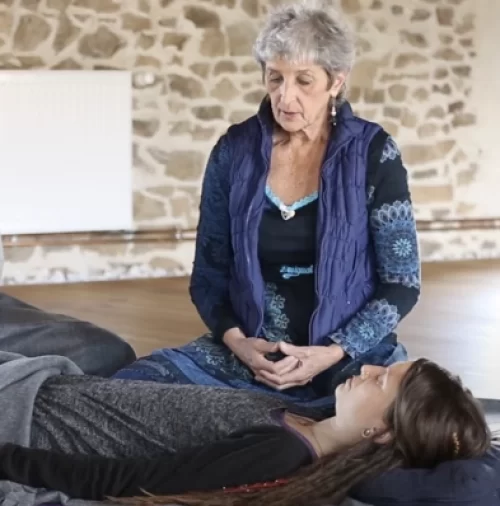CONSCIOUS BREATHING FOR TRAUMA RECOVERY (CBTR)
Free online conscious breathing education that is both simple and effective

The CBTR training has been created by Brigitte Martin Powell and Judee Gee, breath specialists and breathwork trainers based in the UK and in France. Judee and Brigitte are former Presidents of the IBF. At the time of developing this programme they were sitting on the IBF-UN working group committee which develops Conscious Breathing projects in alignment with the United Nations 2030 Agenda for Sustainable Development.
The CBTR programme was originally designed for refugees, migrants and victims of natural disasters as well as health care workers, staff and volunteers of relief organisations.
It has been now extended to include anyone suffering from trauma, anxiety, burnout and depression.
The goal of the CBTR programme is to provide free online conscious breathing education that is both simple and effective through:
- Giving practical instructions for developing an awareness of current breathing habits
- Teaching specific breathing exercises to recalibrate the autonomic nervous system
What is coherent breathing
Coherent Breathing and the Autonomic Nervous System
A major component of the stress response system is the autonomic nervous system, which manages the automatic functions of the body, including the cardiovascular, respiratory, digestive, hormonal, glandular and immune systems. The autonomic nervous system has two main branches: the sympathetic nervous system – the fight or flight system – and the parasympathetic nervous system – the rest and digest or feed and breed– system.
Ideally, both systems are required to intervene for specific actions through our daily life, but in the long run a balance between the two is necessary. A body that is constantly under mental, physical or emotional stress (sympathetic system) without time to rest, integrate and replenish (parasympathetic system), will not be able to function optimally and will suffer the consequences.

There is one automatic function of the body that can be voluntarily controlled through our breath and that is the respiratory system! Conscious breathing techniques provide easy access to the autonomic communication network and by changing our breathing patterns, we send specific messages to the brain that have powerful effects on our thoughts, emotions and behaviours. For example, when we feel anxious, just a few minutes of Coherent Breathing can calm our worried mind and foster more rational – rather than impulsive – decision-making.
Coherent Breathing Practice: Breathing at the rhythm of 5 breaths per minutes is the optimal breathing rhythm for rebalancing the body and accessing an inner state of relaxation that is both peaceful and restful. Five breaths per minute corresponds to breathing in for 6 seconds and out for 6 seconds, linking the in-breath and out-breath in a relaxed way.
How to practice: Start progressively, breathing consciously and in a relaxed way for 3 seconds in and 3 seconds out, until it feels comfortable. Then move on to breathing for 4 seconds in and 4 seconds out and progress at your own rhythm up to 6 seconds in and 6 seconds out. Taller people might want to breathe more slowly.
Where to practice: Start by finding a quiet spot where you can be undisturbed for several minutes. Soft light conditions or darkness will help you to relax. Have a light blanket on hand to be sure you stay warm. Sit or lie down in a comfortable position and start your practice. Once you feel comfortable with the practice you can apply it in a wide range of situations (sitting, walking…).
When to practice: Three times a day for five minutes (365) is a great beginning, and if you can apply the practice daily for a few weeks, you will reap the most benefits. Even one minute of coherent breathing will help rebalance your nervous system. Stephen Elliot suggests 20 min per day for a period of 21 days in order to recalibrate the nervous system and install the coherent breathing reflex as a default practice.
The CBTR training has been created by Brigitte Martin Powell and Judee Gee, breath specialists and breathwork trainers based in the UK and in France. Judee and Brigitte are former Presidents of the IBF. At the time of developing this programme they were sitting on the IBF-UN working group committee which develops Conscious Breathing projects in alignment with the United Nations 2030 Agenda for Sustainable Development.
CBTR VIDEOS
Watch the trailer:
Watch the Presentation:
Watch the Demonstration:
Credits
Thanks to the IBF Development Fund for funding the development of the CBTR training programme in Athens, Greece.
THE CBTR MANUALS
THE IBF BREATHING APP
This free app is the perfect tool to practice the CBTR Program – and much more.
It is now available for free for iPhones on the Apple Store and for Androids on the Google Play Store. The name of the app is IBF Breathing App.
If you want to get more detailed information about the IBF Breathing app, click here:

For more information about Coherent Breathing
Keywords for Internet search
Conscious Breathing
Breathwork
Coherent Breathing
Stephen Elliott
Sympathetic and Parasympathetic Nervous System
Heart Rate Variability (HRV)
Disclaimer
This presentation is designed to provide helpful guidance for recovering from trauma and reinforcing natural resiliency, but should not be used to diagnose or treat any health or medical conditions requiring medical supervision.
The publisher and authors are not liable for any consequences from the application by any person using the information provided in the presentation. Even though conscious breathing is simple and safe, some may find this method challenging, and are encouraged to consult a conscious breathing specialist in order to progress in the practice.